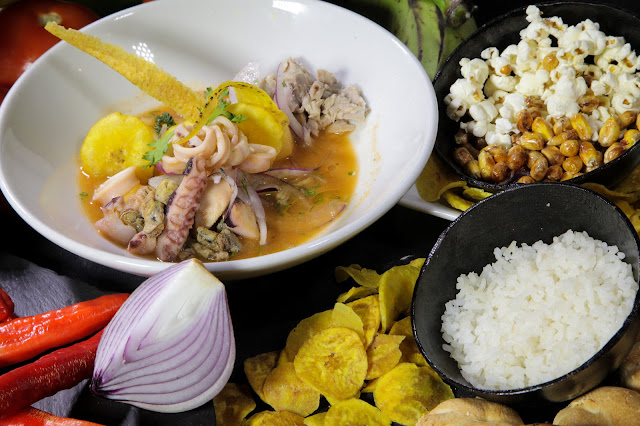This is because the country has four natural regions which have different, traditions, climates, variety of spices and products. Based on the natural regions of the country, several typical dishes are made by their local ingredients.
Even though it was created in the Coast, the encebollado is a very popular soup consumed in every corner of the country. Products for exportation such as albacore tuna which are well known in the European and Asian markets are used for its preparation. The recipe also contains yucca, onions, tomatoes, lemon, pepper and some add Peruvian pepper; but each encebollado its own unique taste given by who prepares it. You can eat it with plantain chips, popcorn, rice, bread, avocado, and fried plantains.
This is one of Ecuadorian’s favorite soups. The "experts" say it is perfect to get you out of a hangover after a night out drinking, so, the best time to eat it is between dawn and morning.
In the pictures below are our best culinary samples of the encebollado, which can be prepared in different ways with each regions own characteristic ingredients.
Aunque nació en la Costa, el encebollado es una sopa muy popular consumida en todos los rincones del Ecuador. Para su preparación se utilizan productos de exportación como el atún y la albacora los cuales se han posicionado en mercados europeos y asiáticos. La receta contiene yuca, cebolla, tomate, pescado, limón, pimiento y algunos le agregan ají peruano; pero cada encebollado lleva el sello de quien lo prepara. Se lo acompaña con chifles, canguil, arroz, pan, aguacate, patacones y hasta con cocolón.
Ésta es otra sopa preferida por los ecuatorianos. Dicen los “expertos” que es el plato perfecto para sacarte de un chuchaqui (resaca) después de una noche de tragos, por eso, la hora favorita de consumirlo es entre la madrugada y la mañana.
En las siguientes imágenes encontramos nuestras mejores muestras culinarias, el encebollado, el que se puede preparar de diferentes formas con ingredientes propios y característicos de cada región.
 |
| (Photo by: Ministerio de Turismo) Pichincha
Encebollado from the Andes is accompanied by popcorn and
toasted corn..
El encebollado serrano se acompaña con canguil y maiz tostado.
|
 |
| (Photo by: Ministerio de Turismo) Napo
Yellow yucca is its most distinctive ingredient.
La yuca amarilla es su ingrediente más distintivo.
|
 |
| (Photo by: Ministerio de Turismo) Manabí
This dish is prepared with peanuts and the octopus.
A este plato se lo prepara con maní y pulpo.
|
 |
| (Photo by: Ministerio de Turismo) Machala
Its main touch is shrimp and is found throughout the
country.
Su toque principal es el camarón y se lo encuentra en todo el país.
|
Like what you’ve read? Feel free to share this post by using the super-easy buttons on the left!¿Te gustó lo que leíste? No dudes en compartir este post usando los botones de la izquierda!























